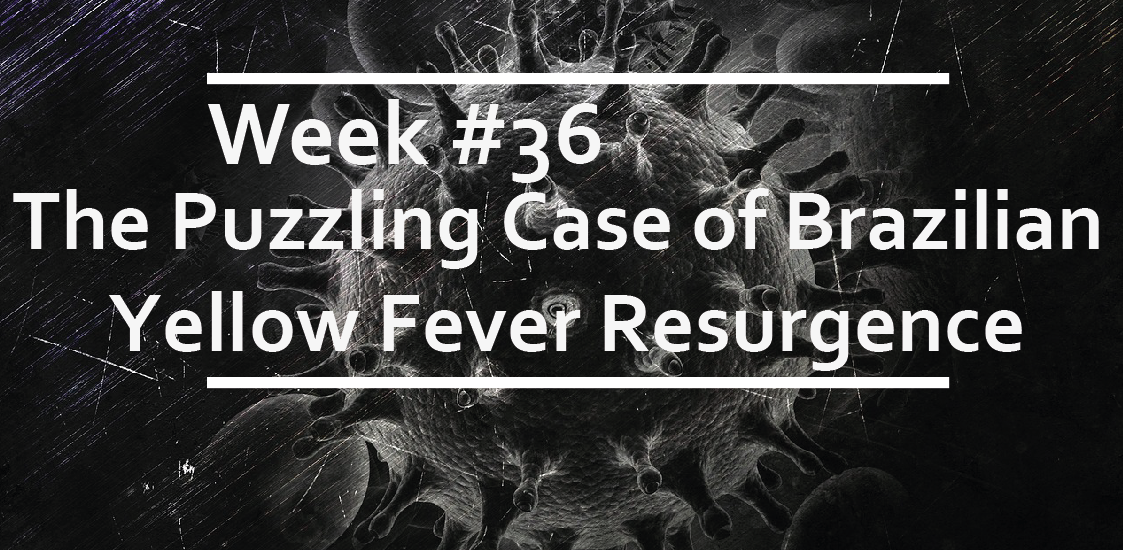The Puzzling Case of Brazilian Yellow Fever Resurgence
Yellow fever virus (YFV) is the etiologic agent of yellow fever, an acute hemorrhagic disease transmitted by infected Aedes aegypti mosquitoes.
Although there is no specific antiviral drug for yellow fever, a vaccine has been available since 1937. This YFV vaccine is considered extremely effective at conferring sustained immunity and life-long protection against yellow fever disease.
Despite the availability of an effective vaccine, there has been a recent resurgence of yellow fever cases in tropical areas of Africa and Central-South America.
Towards the end of 2016, it became clear that a large epidemic of yellow fever was underway in Brazil. This outbreak lasted until March 2018, with more than 2000 confirmed cases of yellow fever across ten states.
YFV transmission mainly occurs through sylvatic mosquito vectors involving non-human primates (NHPs). However, YFV transmission can also occur via an urban cycle, in which Aedes aegypti mosquitoes infect humans.
In this week’s VRS blog, we highlight a study aiming to decipher the origin of the YFV responsible for the recent Brazilian outbreak of yellow fever (2016-2018). Faria et al. combine genetic, epidemiological, and spatial data to provide insight into YFV transmission.
First, Faria et al. aimed to characterize the movement of YFV during the Brazilian outbreak.
A pattern of geographic spread
The study’s authors first sought to understand the correlation between the confirmed cases of yellow fever in humans and those in NHPs. To do so, they performed a time series analysis, a statistical technique that deals with a sequence of values taken in a series of time periods or intervals. This approach helps identify the nature of the phenomenon and can also helps forecast trends by predicting future values of the time series variable.
Faria et al. found a strong association between the human and NHP yellow fever cases; infection in both groups peaked in late January 2017, with an estimated lag of 4 days between the NHP and human cases. Although the NHP cases were more dispersed geographically than the human cases, the number of human and NHP cases per municipality were positively correlated.
To better correlate the human cases with sylvatic infection, the distance between the residence of each human case and the nearest NHP habitat was established using the enhanced vegetation index, which provides a measure of the greenness of an area. The authors found that human HFV cases reside, on average, 1.7 km from the nearest NHP case. Based on this finding, Faria et al. propose that living or working in forested areas is a risk factor for contracting yellow fever in Brazil.
The risk of virus exposure
From the characteristics of age and sex of infected individuals, one can trace back the nature of YFV outbreak and understand if it is driven by sylvatic or urban transmission. The incidence of YFV was highest in 40- to 49-year-old males. This finding suggests that the disease is being transmitted by the sylvatic route since, under an urban cycle, the authors would expect a more uniform exposure across age and sex classes.
The spillover from susceptible primates
Next, the authors used genome sequencing of the YFV to quantitatively track the dynamics of the zoonosis during the course of the outbreak. Comparing YFV from infected humans and NHPs, Faria et al. found that the genomes were highly similar. A phylogenic analysis revealed that the outbreak had originated in northeastern Brazil by vector abundance (three hole-breeding mosquitoes) and accumulation of susceptible NHP hosts, and then moved southward toward densely populated areas, such as Rio de Janeiro and Sao Paulo.
Many additional genomic sequences are needed to understand virus activity, especially for an RNA virus such as YFV, which is continuously mutating. Although this paper reveals how virus genomes can be a valuable source of information about epidemic dynamics, some important points remain to be addressed in future studies.
The article indicates that “most human cases (98.5%) were reported in municipalities with estimated YFV vaccination coverage above the 80% threshold recommended by the World Health Organization (WHO)”, however this observation is not followed up further. The vaccine against yellow fever is extremely efficient at providing protection, however in this study virus sequencing from people that had been vaccinated is shown not to correspond to the vaccine strain, suggesting new infection. Outstanding questions not address in this study are what percentage of symptomatic individuals were vaccinated, when vaccination was administered, whether the infection was milder for vaccinated individuals, and whether the differences between the epidemic strains and the vaccine can reduce vaccine effectiveness. However this information would be important to understand the dynamics of YF infection in the context of an existing vaccination programme.
In his commentary, Alan Barrett accounts for two periods (one in Africa in early 2016, and one in Brazil in December of the same year) where a dose-sparing regimen (one-fifth of the full dose) had to be used because of vaccine shortages. While previous testing in an epidemic context have validated this strategy, it would be interesting and useful to further explore the effect of this reduced regime in terms of efficacy and longevity of the immune response. Importantly, the re-emergence of YF in tropical countries and its recurrent spillage from sylvatic area indicate that more vaccine doses will be needed in the coming years. Governments and regulatory bodies should invest in supporting manufacturing resources where supply can rapidly increase to meet demand during critical times.




